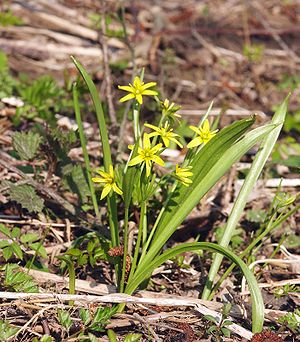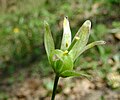Forest yellow star
| Forest yellow star | ||||||||||||
|---|---|---|---|---|---|---|---|---|---|---|---|---|

Forest yellow star ( Gagea lutea ) |
||||||||||||
| Systematics | ||||||||||||
|
||||||||||||
| Scientific name | ||||||||||||
| Gagea lutea | ||||||||||||
| ( L. ) Ker Gawl. |
The forest yellow star ( Gagea lutea ), also known as the common yellow star or forest gold star , is a species of the yellow star ( Gagea ) species.
description
features
The forest yellow star is a graceful, perennial herbaceous plant . As an onion geophyte , it forms underground onions as survival organs. These are characterized by fleshy scales, which arise from a thickening of the leaf sheaths. It reaches heights of growth of 10 to 30 centimeters, which corresponds approximately to the height of its inflorescences.
The forest yellow star develops a basal linear leaf that is up to 10 millimeters wide and shows weak keels. At the top, the leaf runs out like a hood. The thread-like youth leaves are 5-edged - in contrast to the other native yellow star species, in which the thread-like youth leaves are round, triangular or have a V-shaped cross-section. Under the inflorescence two leaf-like, ciliate bracts are formed, which are noticeably shorter than the basal leaf. Otherwise the stem is bare.
Usually a few flowers stand together on a bare flower stalk in shawny inflorescences. The hermaphrodite flowers are threefold. The six golden yellow bracts are 12 to 15 millimeters long and usually run out bluntly.
The loculicidal capsule fruit contains many seeds .
The forest yellow star is hexaploid with a chromosome number of 2n = 72.
ecology
The forest yellow star is a spring green onion - Geophyt . As an early bloomer, it moves in early and is therefore no longer visible in summer. The assimilation surpluses that are passed into the onion at the end of the last vegetation period and stored there form the reservoir for early budding and the development of the shoot system in the next year. The onion also ensures vegetative reproduction . Rarely, this also occurs via brood bulbs, so-called bulbils , in the inflorescence area. It is then a pseudoviviparia .
Its flowers are pre-male, odorless, "nectar-bearing disc flowers". The nectar is in septal nectaries, i. H. between the ovary fans, formed. Pollinators are small flies , beetles and bees . Self- pollination is possible in wet weather and before blooming . The flowering period is between March and May.
The seeds are spread by the wind and by ants (for which an elaiosome is designed). The fruit ripens from May to June.
Occurrence
The forest yellow star has a disjoint European-East Asian distribution area . In Europe the main area of distribution is from eastern France to the Urals , from southern Norway and southern Sweden in the north to northern Italy and the Balkan mountains in the south. In East Asia the area extends from Kamchatka to Sakhalin to the Japanese Islands. In the Allgäu Alps in Bavaria near the Koblachhütte north of Warth (Vorarlberg) it rises to an altitude of up to 1920 meters.
The forest yellow star occurs in deciduous forests, alluvial forests, bushes, at the edges of streams and in meadows. It grows on moist, nutrient-rich garbage soils of the colline to montane altitude , especially over lime.
The forest yellow star usually thrives in shady locations. It often grows in association with wild garlic . You can also meet him in company with the yellow anemone. He is in Central Europe, a federation characteristic species of Alno Ulmion.
Taxonomy
The new combination to Gagea lutea (L.) Ker Gawl. was published by John Bellenden Ker Gawler . Synonyms for Gagea lutea (L.) Ker Gawl. are for example: Gagea erubescens Besser , Gagea burnatii A.Terracc. , Gagea silvatica (Pers.) Loudon , Gagea reverchonii Degen .
Common names
The other German-language trivial names exist or existed for the forest yellow star : Acker onion, Ahmdamsblom ( Mecklenburg ), Erdnüss ( East Prussia ), field onion, Gelbstern ( Württemberg ), Gerstbleaml ( Tyrol in Pinzgau ), Gilbstern ( Thuringia ), Goldstern, Haberschmirgel ( Silesia ), star from Bethlehem ( Ulm ) and goat's leek (East Prussia).
Picture gallery
literature
- Manfred A. Fischer, Wolfgang Adler, Karl Oswald: Excursion flora for Austria, Liechtenstein and South Tyrol . 2nd, improved and enlarged edition. State of Upper Austria, Biology Center of the Upper Austrian State Museums, Linz 2005, ISBN 3-85474-140-5 .
- Erich Oberdorfer : Plant-sociological excursion flora . With the collaboration of Theo Müller. 7th, revised and expanded edition. Eugen Ulmer, Stuttgart (Hohenheim) 1994, ISBN 3-8252-1828-7 .
- Rudolf Schubert , Klaus Werner, Hermann Meusel (eds.): Excursion flora for the areas of the GDR and the FRG . Founded by Werner Rothmaler. 13th edition. tape 2 : vascular plants . People and knowledge, Berlin 1987, ISBN 3-06-012539-2 .
- Siegmund Seybold (Ed.): Schmeil-Fitschen interactive . CD-ROM, version 1.1. Quelle & Meyer, Wiebelsheim 2002, ISBN 3-494-01327-6 .
Individual evidence
- ^ Gagea identification key
- ↑ a b c d e Ruprecht Düll , Herfried Kutzelnigg : Pocket dictionary of plants in Germany and neighboring countries. The most common Central European species in portrait . 7th, corrected and enlarged edition. Quelle & Meyer, Wiebelsheim 2011, ISBN 978-3-494-01424-1 .
- ↑ Erhard Dörr, Wolfgang Lippert : Flora of the Allgäu and its surroundings. Volume 1, IHW, Eching 2001, ISBN 3-930167-50-6 .
- ^ Erich Oberdorfer : Plant-sociological excursion flora for Germany and neighboring areas. 8th edition. Stuttgart, Verlag Eugen Ulmer, 2001. ISBN 3-8001-3131-5
- ^ Georg August Pritzel , Carl Jessen : The German folk names of plants. New contribution to the German linguistic treasure. Philipp Cohen, Hannover 1882, p. 156, archive.org
Web links
- Forest yellow star. In: FloraWeb.de.
- Forest yellow star . In: BiolFlor, the database of biological-ecological characteristics of the flora of Germany.
- Profile and distribution map for Bavaria . In: Botanical Information Hub of Bavaria .
- Gagea lutea (L.) Ker Gawl. In: Info Flora , the national data and information center for Swiss flora .
- Distribution in the northern hemisphere from: Eric Hultén, Magnus Fries: Atlas of North European vascular plants. 1986, ISBN 3-87429-263-0 at Den virtuella floran. (swed.)
- Thomas Meyer: Data sheet with identification key and photos at Flora-de: Flora von Deutschland (old name of the website: Flowers in Swabia ).






